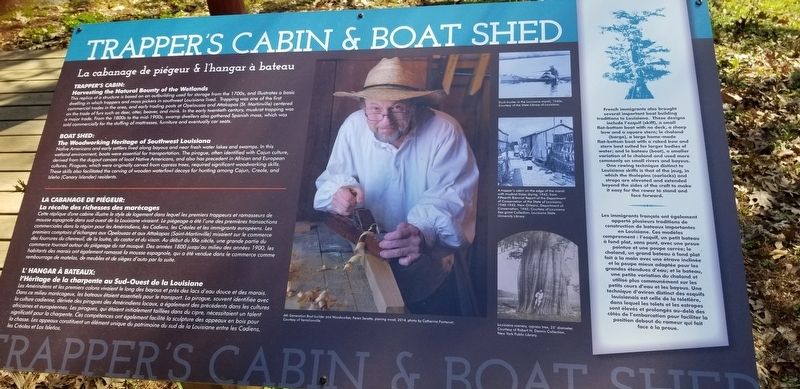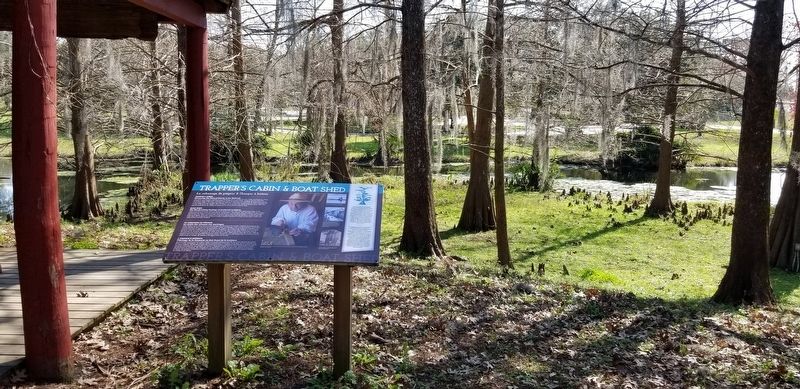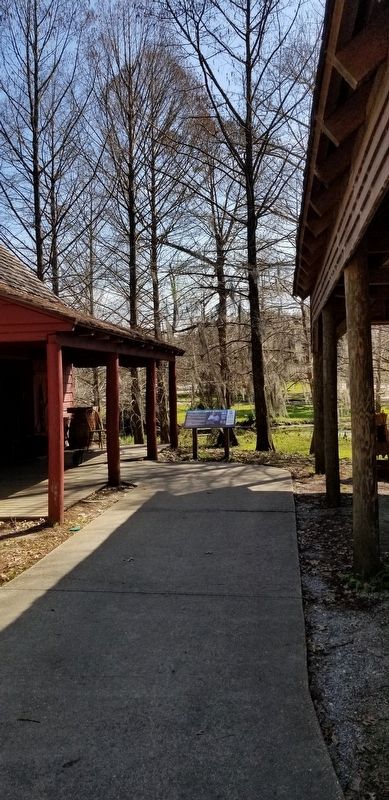Trappers Cabin & Boat Shed
La cabanage de piégeur & l'hangar à bateau
TRAPPER'S CABIN:
Harvesting the Natural Bounty of the Wetlands
This replica of a structure is based on an outbuilding used for storage from the 1700s, and illustrates st a basic dwelling in which trappers and moss pickers in southwest Louisiana lived. Trapping was one commercial trades in the area, and early trading posts at Opelousas and Attakapas (St. Martinville) centered on the trade of furs such as deer, otter, beaver, and mink. In the early twentieth century, musk trapping a major trade. From the 1800s to the mid-1900s, swamp dwellers also gathered Spanish moss, which was sold commercially for the stuffing of mattresses, furniture and eventually car seats.
BOAT SHED:
The Woodworking Heritage of Southwest Louisiana
Native Americans and early settlers lived along bayous and near fresh water lakes and swamps. In this wetland environment, boats were essential for transportation. The pirogue, often identified with Cajun culture, derived from the dugout canoes of local Native Americans, and also has precedent in African and European cultures. Pirogues, which were originally carved from cypress trees, required significant woodworking skills. These skills also facilitated the carving of wooden waterfowl decoys for hunting among Cajun, Creole, and Isleño (Canary Islander)
LA CABANAGE DE PIEGEUR:
La récolte des richesses des marécages
Cette réplique d'une cabine illustre le style de logement dans lequel les premiers trappeurs et ramasseurs de mousse espagnole dans sud-ouest de la Louisiane vivaient. Le piégeage a été l'une des premières transactions commerciales dans la région pour les Amérindiens, les Cadiens, les Créoles et les immigrants européens. Les premiers comptoirs d'échanges aux Opelousas et aux Attakapas (Saint-Martinville) misaient sur le commerce des fourrures du chevreuil, de la loutre, du castor et du vison. Au début du XXe siècle, une grande partie du commerce toumait autour du piégeage du rat musqué. Des anneés 1800 jusqu'au milieu des années 1900, les habitants des marais ont également ramassé la mousse espagnole, qui a été vendue dans le commerce corn me rembourrage de matelas, de meubles et de sieges d'auto par la suite.
L' HANGAR À BATEAUX:
l'Héritage de la charpente au Sud-Ouest de la Louisiane
Les Amérindiens et les premiers colons vivaient le long des bayous et prés des lacs d'eau douce et des marais. Dans ce milieu marécageux, les bateaux étaient essentiels pour le transport. La pirogue, souvent identifiée avec a culture cadienne, dérivée des pirogues des Amérindiens locaux, a également des précedénts dans les cultures fricaines et européennes.
Side Bar
French immigrants also brought several important boat building traditions to Louisiana. These designs include l'esquif (skiff), a small flat-bottom boat with no deck, a sharp bow and a square stern; le chaland (barge), a large home-made flat-bottom boat with a raked bow and stern best suited for larger bodies of water; le bateau (boat), a smaller variation of le chaland and used more commonly on small rivers and bayous.
One rowing technique distinct to Louisiana skiffs is that of the joug, in which the tholepins (oarlocks) and straps re elevated and extended beyond the sides of the craft to make it easy for the rower to stand and face forward.
---------------------------------------------------------------------------
Les immigrants français ont également apporté plusieurs traditions de construction de bateaux importantes en Louisiane. Ces modèles comprennent : l'esquif, un petit bateau à fond plat, sans pont, avec une proue pointue et une poupe carrée; le chaland, un grand bateau à fond plat fait à la main avec une étrave inclinée
et la poupe mieux adaptée pour les grandes étendues d'eau; et le bateau, une petite variation du chaland et utilisé plus communément sur les petits cours d'eau et les bayous. Une technique d'aviron distinct des esquifs louisianais est celle de la toletiére, dans lequel les tolets et les estropes sont élevés et prolongés au-delà des côtés de I'embarcation pour faciliter Ia position debout du rameur qui fait face à la proue.Topics. This historical marker is listed in these topic lists: Native Americans • Settlements & Settlers • Waterways & Vessels.
Location. 30° 12.897′ N, 91° 59.664′ W. Marker is in Lafayette, Louisiana, in Lafayette Parish. Marker can be reached from Fisher Road near Surrey Steet (State Highway 728-8). Touch for map. Marker is at or near this postal address: 300 Fisher Road, Lafayette LA 70508, United States of America. Touch for directions.
Other nearby markers. At least 8 other markers are within walking distance of this marker. Buller House (within shouting distance of this marker); The Forge (within shouting distance of this marker); Mouton Kitchen (within shouting distance of this marker); Attakapas Chapel (within shouting distance of this marker); The Presbytery (within shouting distance of this marker); School House (within shouting distance of this marker); Mouton House (within shouting distance of this marker); Beau Bassin House (within shouting distance of this marker). Touch for a list and map of all markers in Lafayette.
More about this marker. Located on the grounds of the Vermilionville Heritage Museum, Admission required.
Also see . . . Museum Website. (Submitted on May 30, 2019, by Cajun Scrambler of Assumption, Louisiana.)
Credits. This page was last revised on November 28, 2022. It was originally submitted on May 30, 2019, by Cajun Scrambler of Assumption, Louisiana. This page has been viewed 270 times since then and 46 times this year. Photos: 1, 2, 3. submitted on May 30, 2019.


